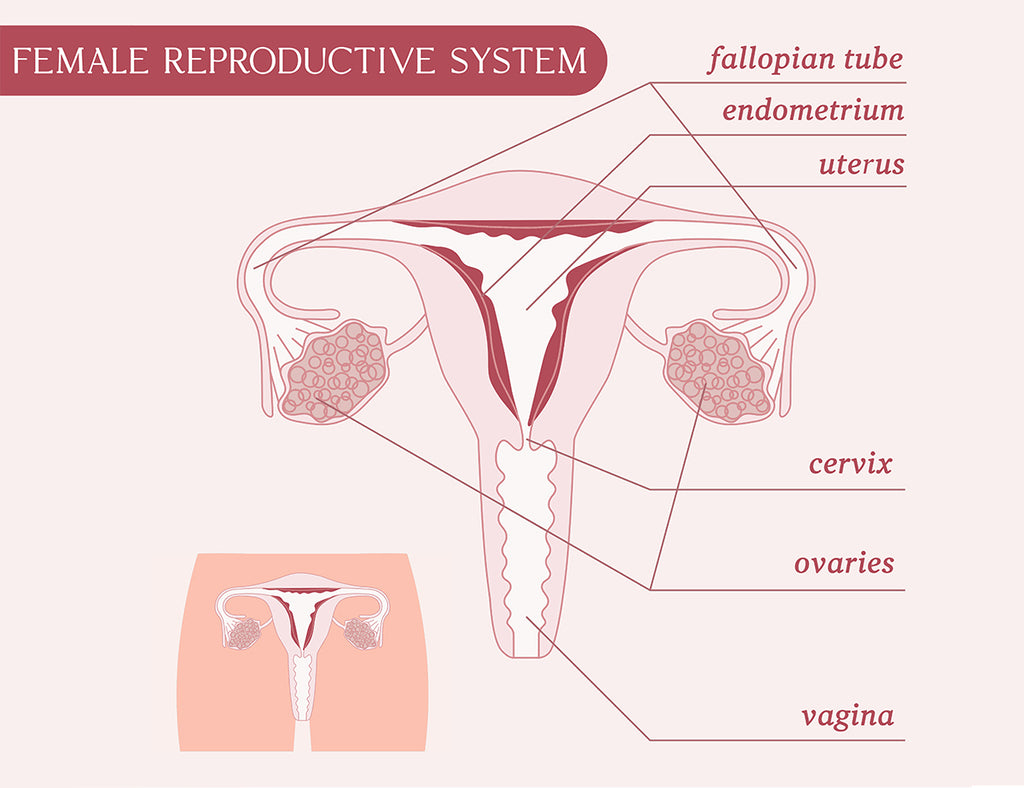There are times in a woman’s life when her cervix seems to be a topic of daily conversation. If you’re wanting to conceive, you may be experimenting with how to check your cervix for fertility awareness. Or, if you’re expecting a baby any day, it may seem like everyone wants to know how dilated you are!
How to Check Your Cervix
Spending a few minutes getting to know what your cervix is up to can help you use a period cup, track your cycle, and take control of your fertility.
While it may seem foreign at first, knowing cervix position changes can help with several things in your feminine care. Let's explore what you need to know and get you started!

What is the Cervix?
If you're just starting your journey with trying to conceive or if you're simply intrigued by how your body works, the first step is knowledge with understanding. Women can be empowered to take more control of their health and wellness as they learn how their bodies operate and why it matters.
So today, let’s start with the basics.

The cervix is the cylinder-shaped neck of tissue between the uterus and vagina, with openings on either end. It is usually about 2-3 centimeters long (1 inch) and the lower portion bulges into the top of the vaginal canal. The cervix changes texture and position throughout a woman’s menstrual cycle and flattens and dilates during childbirth to allow a baby to be born vaginally.
High vs. Low Cervix
Some women have a high cervix and some have a lower one. Either can be healthy, safe, and strong. Every woman is different so it is important to check your cervix at multiple points throughout your cycle to determine what is a high or low position for your cervix.
Period Care Tip: How high or low it is may impact your comfort level when wearing a period cup. It’s great to get familiar with your anatomy if you’re experimenting with different cups and how long or short you keep the stem of the cup.
Curious how alternative period care can help you? Read more about finding the best menstrual cup for you and how to use a period cup.
Finding Cervix Position
To check your cervix position, simply place one finger in your vagina and feel for something that feels like the top of your nose — a bit firm and bumpy and you may feel the opening in the middle. Basically, if you feel anything other than soft vaginal walls there is a good chance this is your cervix.
If it's lower, it will be closer to the vaginal opening, or if you have a hard time finding it, your cervix is probably higher up. To know for sure, use your thumb as a place holder after inserting your longest finger so you can then measure with a ruler how far in your cervix is.
A high cervix is considered anything 2.25" (55 mm) or more deep. A cervix is considered low when it is 1.6" (44 mm) or less from your vaginal opening.

Your Cervix During Ovulation and the Cycle
Day One of the Cycle
Your menstrual cycle starts on the day that you begin your period. Your cervix is normally low and hard at that point and slightly open to allow the blood to flow out. If you want to check it during this time, it probably feels like the tip of your nose. After your period ends, the cervix remains low and hard and the uterine opening remains closed.
Through Your Cycle
As you get closer to ovulation, the cervix rises up toward the top of the vagina and becomes soft and moist. You’ll also notice an increase in cervical mucus and it will feel slightly softer.
At the peak of ovulation, your cervix will feel more like your lips than your nose. The uterus opens to allow sperm to enter and increase your chances of getting pregnant.
Cervix Position During Ovulation
During ovulation, your cervix might be so soft and high that it seems to disappear — this just means that it is blending in with the vaginal walls. At the most fertile point in your cycle, your cervix is Soft, High, Open, and Wet - or SHOW.
Your Cervix After Ovulation
After you ovulate, your cervix descends again and becomes more firm. The uterine opening will become tightly closed. Every woman is different in how quickly her body goes through these changes — it can happen immediately after ovulation or it may take up to several hours or days.
Your Cervix During Pregnancy
If you become pregnant, the cervix will stay high but the uterine opening will remain tightly closed. The cervix will be soft because it becomes swollen with increased blood flow.
Because this movement occurs at different times for different women, it’s not a great way to determine if you are indeed pregnant. It can happen as early as 12 days after ovulation or well after the pregnancy has been confirmed by a test.
Checking Your Cervix
So now that you’re familiar with the potential positions and how your body works throughout your cycle, you’re ready to analyze your own body.
Whenever you’re checking and for whatever reason, you always want to make sure that you keep everything clean and sanitary to avoid infection.
The Best Time to Check Your Cervix
If you’re checking for period cup use, you can check it during your period or (if that makes you squeamish) immediately after.
If you’re wanting to check to know your most fertile days, you should check yourself every day at the same time.
Some specific times that you wouldn’t want to check yourself are after sex, because your position will vary due to arousal, or if you’re dealing with any kind of infection.
How to Check Your Cervix
To check your cervix, be sure your nails are trimmed and your hands are washed. You want to find a comfortable position that will allow you to easily reach your cervix, similar to the position needed for putting in a tampon. Consider sitting on the toilet, putting one leg up on the edge of the bathtub, or squatting.
Then, with a clean hand (we can’t stress this enough!), reach your index or middle finger inside of your vagina and slide your finger in as far as you can reach. You’ll want to use a sort of in and upward motion. You’re checking for three things - height, firmness, and openness.
Is your cervical position high, medium, or low? Lower means you may be able to reach your cervix with your fingers inserted only to your knuckle, while higher may mean inserting a whole finger and still not being sure if you can reach it. As you approach ovulation, your cervix moves up and back, making it further away and harder to reach.
Next is firmness. Estrogen softens the cervix, making it feel softer. When it is hard it may feel like the tip of your nose. At your most fertile, while you are approaching ovulation, it may feel soft like your lips.
Lastly, gently check to see if your cervix is open or closed. Your cervix will be slightly open (no more than a thin slit) just before ovulation. It will open again during menstruating, but at that point, the cervix will be lower than at ovulation.
Don’t be surprised or worried if your cervix always feels slightly open, especially if you’ve ever given birth. That’s totally normal and the other changes will still be noticeable.
Write down your cervical position on a fertility chart or in an app. Keeping track will not only help you understand and identify changes in your cycle, but it can help you detect ovulation or even confirm pregnancy!

Checking Your Cervix During Labor
If you’re closing in on your due date and want to check your cervix, keep in mind that repeated checks, even with clean hands, can introduce bacteria — especially if your water has already broken. Your cervix may feel like puckered lips throughout pregnancy and during the early stages of labor. And as your cervix is dilated, you may be able to slide a finger (or more) into the opening easily.

Be careful to avoid poking and prodding too aggressively. Be especially gentle if you think you may feel your amniotic sac just beyond your cervix. One centimeter is about one finger width, so you can use that to estimate how far you are dilated.
Knowing Your Normal
Checking your cervix is a great way to take control of your fertility, get in touch with your body for period care, or simply to know your "normal."
This process is particularly helpful if you combine it with other natural tracking methods such as charting cervical mucus and basal body temperature to monitor your fertility window.
Here are some things to remember —
• Wash your hands!
• If you’re feeling nervous, don’t be. You’re not going to hurt yourself!
• Don’t expect to understand what you’re feeling the first, second, or even tenth time you try - this is a skill that comes from practice and patience.
• Don’t check your cervix when you’re aroused or right after sex - it may throw off your charting.
• Ensuring your hands are clean is so necessary, particularly when you’re pregnant.
The woman’s body is an amazing system that’s capable of producing life! Knowing how to check your cervix empowers you in so many ways. Be sure to take care of your body and get to know yourself as you enter into new experiences and life stages!
Follow along with the Femallay Wellness Blog for more ways to naturally care for your feminine health!







